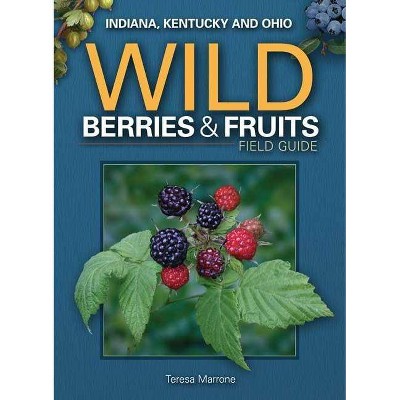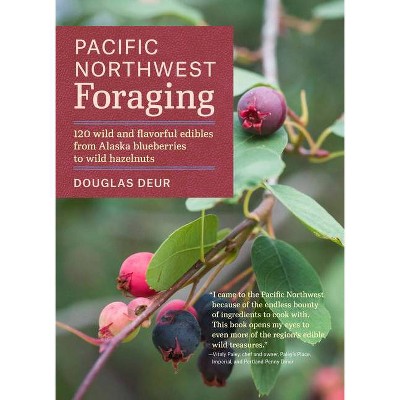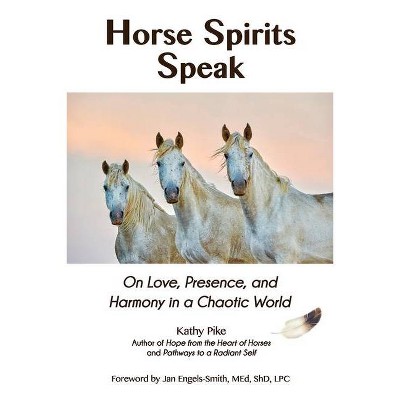Wild Berries & Fruits Field Guide of Illinois, Iowa and Missouri - (Wild Berries & Fruits Identification Guides) by Teresa Marrone (Paperback)

Similar Products
Products of same category from the store
AllProduct info
<p/><br></br><p><b> About the Book </b></p></br></br><p><b>This field guide, organized by color and form, features full-color photographs and information to help readers quickly and easily identify and find wild berries and fruits in Illinois, Iowa and Missouri.</b><p/><br></br><p><b> Book Synopsis </b></p></br></br><p><b>Now you can identify wild berries and fruits!</b> <p>Learn what's edible and what to avoid with this easy-to-use field guide.<br> <ul><li>Species organized by color, then by form</li> <li>Full-page photos and insets showing each plant's key identification points</li> <li>Interesting tidbits about the plants' many uses</li> <li>Range maps, ripening calendar and more</li> <li>Over 200 wild berries and fruits in Illinois, Iowa and Missouri</li></ul> <p>Author Teresa Marrone has been gathering and preparing wild edibles for more than 20 years.<p/><br></br><p><b> Review Quotes </b></p></br></br><br>New books aid in identifying and preparing wild fruits and berries - By SYLVIA ANDERSON St. Joseph News-Press t may seem shocking to some, but before grocery stores and drive-through food chains, people were able to eat off the land. And to a degree, you still can - if you know what you're doing. Fruits and berries grow wild everywhere, but most of us don't know which ones are safe to eat and what to do with them when we do find them. That's why Teresa Marone decided to write "The Illinois, Iowa and Missouri Wild Berries and Fruits Field Guide " She has been gathering and preparing wild edibles for more than 20 years and is the author of numerous outdoors-related cookbooks. Her field guide categorizes each fruit species as toxic (poisonous), not edible, edible or delicious, so you know which berries to pick and which to leave. Her companion cookbook, "Get Cooking with Wild Berries and Fruits of Illinois, Iowa and Missouri," provides more than 175 recipes using the region's edible berries and fruits. We caught up with her recently while she was hunting for berries in southern Ohio. Here's an excerpt fromher interview with the News-Press. Q Where are good places to pick wild fruits and berries in Northwest Missouri and Northeast Kansas? A. Most state and national parks will allow picking of berries and fruits for immediate consumption, but not for commercial use - such as selling at a farmer's market. In general, one needs to check with local authorities to be sure it is legal to harvest wild berries and fruits. Local parks often have walking paths that go through wooded areas, and as long as the park doesn't spray for weeds and has no restrictions about picking, these can be great places for berries. Rural areas can be excellent, but one always has to ask permission from the landowner before entering the land and picking. I often pick around office parks in the outer suburbs, because these often have shelterbelts of trees, shrubs and native vegetation left for visual appeal; no one ever seems to care if I pick wild berries in these places. Sometimes, I've even found edible wild fruits in boulevard strips or on fences surrounding shopping malls, lumber yards and places like that. O. What berries are in season now or are coming up? A. I'm seeing ripe elderberries all over the place right now in Ohio, which is pretty similar to your area; blackberries are also starting to ripen right now and purple-flowering raspberry are still producing. Other fruits that are ripe right now - or very quickly - include gooseberries, ground cherries, plums, chokecherries, wild pears, mayapples, maypops (the fruit of the passionflower vine), crab apples and pawpaws. Grapes and blackhaw ripen in late summer to early fall. Persimmon ripen much later in the fall but are truly wonderful. Q. How should they be stored if you can't cook something right away? A. Most wild berries and fruits are fairly perishable. Whole berries that have no hard pits, such as blackberries, blueberries, ground cherries and gooseberries, can be frozen on a baking sheet in a single layer then packed into freezer bags or container until needed. Berries that have hard pits, such as chokecherries or black cherries, should be juiced or processed into pulp; then the juice or pulp can be frozen or canned until needed. Pawpaws can be mashed and frozen raw. Crab apples and wild pears can be cut up or cooked into sauce (like applesauce) and then canned or frozen. In addition, many wild berries and fruits make excellent fruit leathers; simply puree, then spread on a sheet and dehydrate in a dehydrator or a very low oven. Delicious! Lifestyles reporter Sylvia Anderson can be reached at syviaandenon@newspressnow.com--Sylvia Anderson"St Joseph News Press" (08/11/2010)<br><br>Enjoy fruits of your labor with these recipes Two new books worth noting are "Wild Berries & Fruits Field Guide of Illinois, Iowa and Missouri" and "Cooking with Wild Berries & Fruits of Illinois, Iowa and Missouri." These two books complement each other, especially if you like to go out foraging for what you eat. The field guide is user-friendly, helping you learn what is edible and what to avoid. The cookbook features exciting recipes to enjoy the fruits of your labor. Both titles are available at local book stores or through Adventure Publications by calling (800) 678-7006, online at www.adventurepublications.net. Author Teresa Marrone has been gathering and preparing wild edibles for more than 20 years. She was formerly managing editor of a series of outdoor-themed cookbooks and other books. She also has written magazine articles on wild foods and cooking.--Carol Moore"The Register Mail" (10/04/2010)<br><p/><br></br><p><b> About the Author </b></p></br></br>Teresa Marrone has been gathering and preparing wild edibles for more than 20 years. She was formerly Managing Editor of a series of outdoors-themed books, and is the author of Abundantly Wild: Collecting and Cooking Wild Edibles in the Upper Midwest, as well as numerous other outdoors-related and regional cookbooks. Teresa has also written many magazine articles on wild foods and cooking, and has rekindled an early interest in photography. Wild Berries & Fruits Field Guide of Illinois, Iowa and Missouri combines her various skills and interests into a clear, concise, easy-to-use book that helps the user appreciate the diversity of the various wild berries and fruits that grow in this region. Teresa lives in Minneapolis with her husband, Bruce.
Price History
Cheapest price in the interval: 11.99 on October 22, 2021
Most expensive price in the interval: 11.99 on November 8, 2021
Price Archive shows prices from various stores, lets you see history and find the cheapest. There is no actual sale on the website. For all support, inquiry and suggestion messagescommunication@pricearchive.us




















